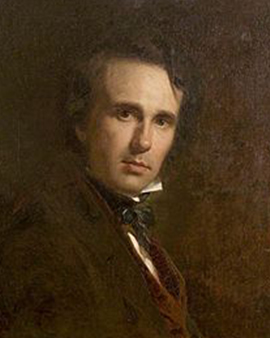The British landscape painter Henry Dawson certainly did not have an easy childhood. At the age of eight and after only a good one and a half years of schooling, he already had to earn money to support his parents. His father was a heavy drinker. So Henry worked long hours every day in a factory that produced lace. In his scarce free time he still managed to teach himself to paint. Apart from a few lessons with the landscape painter James Baker Pyne, Dawson never received formal training as a painter. His works are therefore characterised by an original individuality, especially at the beginning of his career.
When he was a little older and his painting matured with him, Henry Dawson succeeded in selling smaller paintings. At the beginning of his twenties he finally gave up working in the factory completely and devoted himself only to painting. He found supporters and promoters in his well-disposed art friends in his home town Nottingham. Dawson mainly painted landscape paintings in the typical style of English Romanticism: mysterious monastery ruins stand out from an idealized, idyllic green landscape and stand out from a wide sky in pastel colours, cows graze quietly under mighty trees. Dawson played with light and atmosphere, his works convey a longing for peace and quiet, they invite us to dream. His paintings are reminiscent of the William Turners, the most important British painter of the Romantic period. Similar to Turner, Henry Dawson, after moving to Liverpool in 1844, also devoted himself to the design of seascapes: majestic sailing ships glide over the billowing sea, and dramatically billowing clouds sweep across the sky. When William Turner died in 1851, some even saw Henry Dawson as his legitimate successor. And even though Dawson now increasingly oriented himself towards Turner and his style, he always kept his own style.
In 1849 Henry Dawson moved with his family to London and was able to exhibit regularly at the Royal Academy, his works now began to fetch higher prices. Nevertheless, he never quite managed to step out of Turner's shadow and remained almost unknown to a broad public. Only from 1870 on his fame slowly increased and until his death he could finally live well from his art. Henry Dawson himself was always convinced of his ability and even praised his paintings as "kings of art". He also passed his talent on to his children: his two oldest sons, Henry Thomas Dawson and Alfred Dawson, also became painters.
×





.jpg)
.jpg)
_-_(MeisterDrucke-1315706).jpg)
_-_(MeisterDrucke-1315706).jpg)
.jpg)
.jpg)
 1875 - (MeisterDrucke-179782).jpg)
 1875 - (MeisterDrucke-179782).jpg)
.jpg)
.jpg)
.jpg)
.jpg)
.jpg)
.jpg)
.jpg)
.jpg)
.jpg)
.jpg)
.jpg)
.jpg)
.jpg)
.jpg)
.jpg)
.jpg)
 - (MeisterDrucke-280047).jpg)
 - (MeisterDrucke-280047).jpg)
.jpg)
.jpg)
.jpg)
.jpg)
.jpg)
.jpg)
.jpg)
.jpg)
.jpg)
.jpg)
.jpg)
.jpg)
.jpg)
.jpg)
.jpg)
.jpg)
.jpg)
.jpg)
.jpg)
.jpg)
.jpg)
.jpg)
.jpg)
.jpg)
.jpg)
.jpg)
.jpg)
.jpg)
.jpg)
.jpg)
.jpg)
.jpg)
.jpg)
.jpg)
.jpg)
.jpg)
.jpg)
.jpg)
.jpg)
.jpg)
.jpg)
.jpg)
.jpg)
.jpg)
.jpg)
.jpg)
.jpg)
.jpg)
.jpg)
.jpg)
.jpg)
.jpg)
.jpg)
.jpg)
.jpg)
.jpg)
.jpg)
.jpg)
.jpg)
.jpg)
.jpg)
.jpg)




